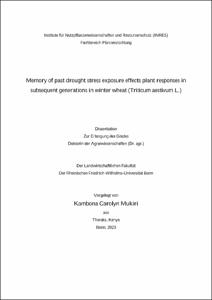Kambona, Carolyn Mukiri: Memory of past drought stress exposure effects plant responses in subsequent generations in winter wheat (Triticum aestivum L.). - Bonn, 2023. - Dissertation, Rheinische Friedrich-Wilhelms-Universität Bonn.
Online-Ausgabe in bonndoc: https://nbn-resolving.org/urn:nbn:de:hbz:5-72759
Online-Ausgabe in bonndoc: https://nbn-resolving.org/urn:nbn:de:hbz:5-72759
@phdthesis{handle:20.500.11811/11150,
urn: https://nbn-resolving.org/urn:nbn:de:hbz:5-72759,
author = {{Carolyn Mukiri Kambona}},
title = {Memory of past drought stress exposure effects plant responses in subsequent generations in winter wheat (Triticum aestivum L.)},
school = {Rheinische Friedrich-Wilhelms-Universität Bonn},
year = 2023,
month = nov,
note = {Current research suggests that plants can memorize the environments experienced by their ancestors to alter their phenotypes. Parental environmental effects have been reported for the first offspring generation, and some studies describe persisting grandparental and great grandparental environmental effects. These inherited environmental effects can include specific developmental adjustments that improve offspring growth under the conditions that induced them. Research on crop stress memory is still in its infancy, despite its potential role in environmental adaptation. The occurrence, persistence, adaptive value, and inheritance of stress memory effects remain unclear, obscuring their evolutionary and ecological significance. Addressing this gap in knowledge would likely improve our ability to breed and manage crops in order to promote stress tolerance. Improving crop response to drought stress is of particular concern, due to the diminishing availability of water in agricultural regions across the globe. Therefore, the overall objective of this research was to investigate the drought stress memory of winter wheat, focusing on the seed, seedling and the reproductive growth stage.
For this purpose, phenotypic plasticity studies were combined with differential gene expression analysis in order to address these outstanding concerns. Winter wheat varieties were grown for two years under drought and controlled moisture conditions to produce seeds with all possible combinations of drought exposure history. Analyses of the seed transcriptome, seedlings and plant biochemical, physiological, and morphological traits, including plant height, above-ground biomass and root architecture alterations illustrated the variability in the expression of memory effects. The performance of plants whose ancestors had been exposed to drought stress in one or more generations was inconsistent, highlighting the strength of each memory effect as well as the complex relationship between cultivars, environments, and their interactions. The results of this research also support the hypothesis that memory imprints include not only the epigenetic marks that alter gene expression but also biochemical and physiological imprints that also modify plant morphology.
While this subject requires further investigation, these results suggest that cultivar specific changes in gene expression due to drought memory may contribute to the regulation of plasticity. The observed cultivar differences underscore the importance of incorporating genetic variation into epigenetic studies. Taken together, the findings in this study indicate that the interactions between different cultivars, environments (offspring environment, parental environment, grandparental environment etc.), and epigenotypes are a meaningful source of phenotypic variation, signifying a promising new direction in plant breeding.},
url = {https://hdl.handle.net/20.500.11811/11150}
}
urn: https://nbn-resolving.org/urn:nbn:de:hbz:5-72759,
author = {{Carolyn Mukiri Kambona}},
title = {Memory of past drought stress exposure effects plant responses in subsequent generations in winter wheat (Triticum aestivum L.)},
school = {Rheinische Friedrich-Wilhelms-Universität Bonn},
year = 2023,
month = nov,
note = {Current research suggests that plants can memorize the environments experienced by their ancestors to alter their phenotypes. Parental environmental effects have been reported for the first offspring generation, and some studies describe persisting grandparental and great grandparental environmental effects. These inherited environmental effects can include specific developmental adjustments that improve offspring growth under the conditions that induced them. Research on crop stress memory is still in its infancy, despite its potential role in environmental adaptation. The occurrence, persistence, adaptive value, and inheritance of stress memory effects remain unclear, obscuring their evolutionary and ecological significance. Addressing this gap in knowledge would likely improve our ability to breed and manage crops in order to promote stress tolerance. Improving crop response to drought stress is of particular concern, due to the diminishing availability of water in agricultural regions across the globe. Therefore, the overall objective of this research was to investigate the drought stress memory of winter wheat, focusing on the seed, seedling and the reproductive growth stage.
For this purpose, phenotypic plasticity studies were combined with differential gene expression analysis in order to address these outstanding concerns. Winter wheat varieties were grown for two years under drought and controlled moisture conditions to produce seeds with all possible combinations of drought exposure history. Analyses of the seed transcriptome, seedlings and plant biochemical, physiological, and morphological traits, including plant height, above-ground biomass and root architecture alterations illustrated the variability in the expression of memory effects. The performance of plants whose ancestors had been exposed to drought stress in one or more generations was inconsistent, highlighting the strength of each memory effect as well as the complex relationship between cultivars, environments, and their interactions. The results of this research also support the hypothesis that memory imprints include not only the epigenetic marks that alter gene expression but also biochemical and physiological imprints that also modify plant morphology.
While this subject requires further investigation, these results suggest that cultivar specific changes in gene expression due to drought memory may contribute to the regulation of plasticity. The observed cultivar differences underscore the importance of incorporating genetic variation into epigenetic studies. Taken together, the findings in this study indicate that the interactions between different cultivars, environments (offspring environment, parental environment, grandparental environment etc.), and epigenotypes are a meaningful source of phenotypic variation, signifying a promising new direction in plant breeding.},
url = {https://hdl.handle.net/20.500.11811/11150}
}






